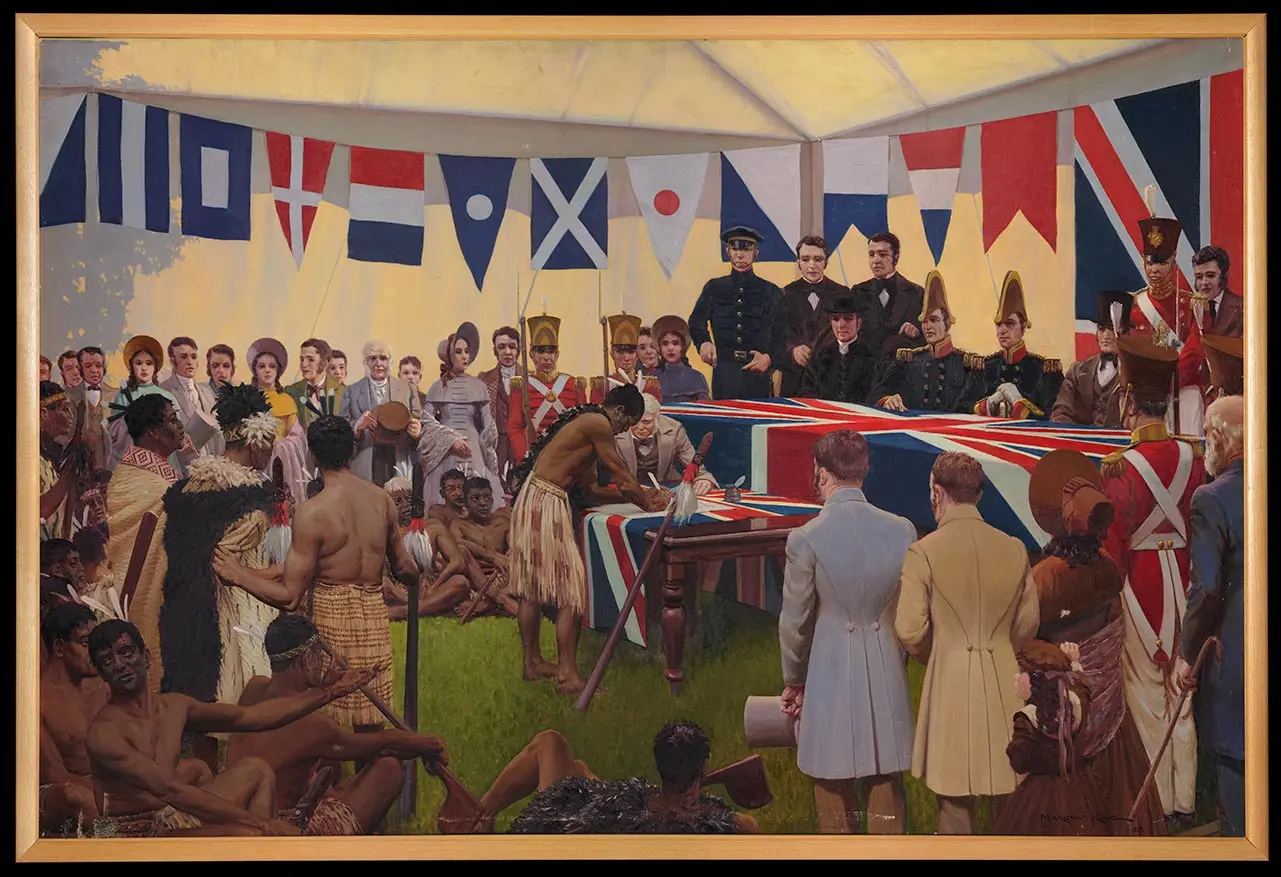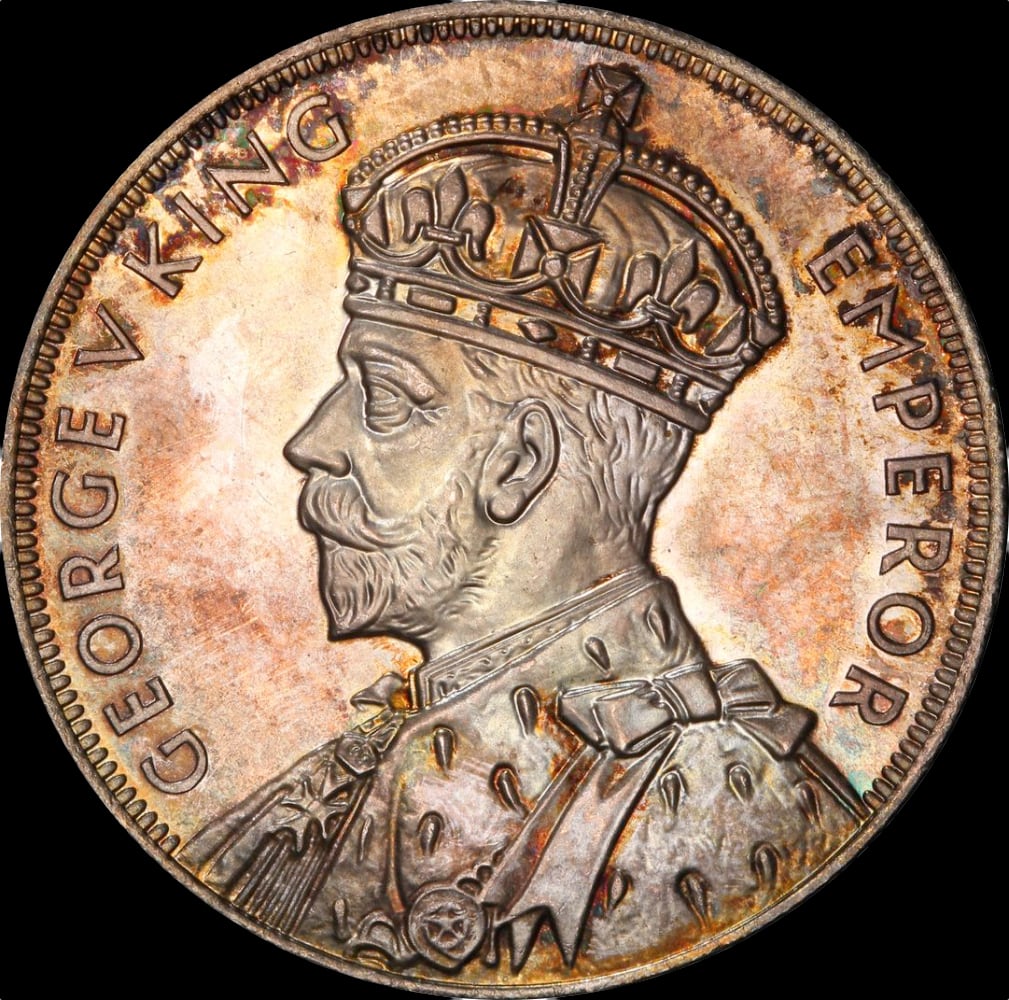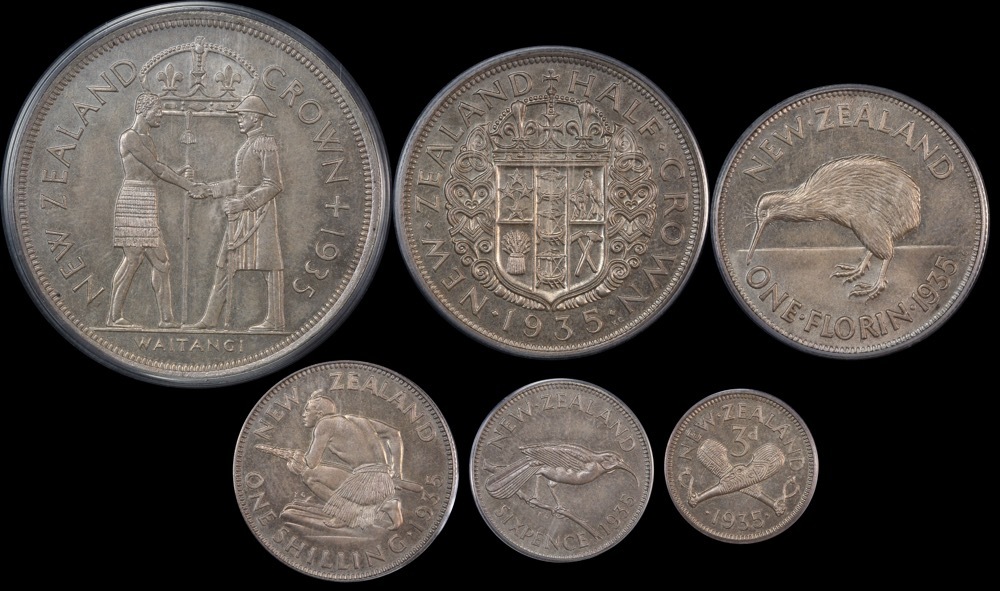New Zealand's 1935 Waitangi Crown Captures a Pivotal Moment in History

The New Zealand 1935 Proof Crown, often referred to as the "Waitangi Crown", holds a unique place in numismatic history. This rare and sought-after coin commemorates the 95th anniversary of the signing of the Treaty of Waitangi, a landmark document that shaped the course of New Zealand's history. Struck in silver and with a limited mintage of just 1,128 coins, the Waitangi Crown is a prized possession for collectors and acts as a fascinating window into the country's past.
In this article, we'll delve into the historical context surrounding the coin's creation, explore its design and specifications, and discuss its rarity, value, and appeal to both coin enthusiasts and history buffs.
A Pact Forged in 1840: The Treaty of Waitangi and its Enduring Legacy

The Signing of the Treaty of Waitangi, February 6th, 1840, 1938 by Marcus King.
Image Source: Ref: G-821-2 Alexander Turnbull Library.
The New Zealand 1935 Proof Crown commemorates not just any historical event, but a pivotal moment in the nation's foundation – the signing of the Treaty of Waitangi. This treaty, signed on February 6, 1840, between representatives of the British Crown and over 500 Māori chiefs, established a unique relationship between the indigenous Māori people and the British settlers.
The treaty aimed to ensure British sovereignty over New Zealand while guaranteeing Māori ownership and control over their lands, forests, and other possessions. In return, Māori were granted the rights and privileges of British subjects. However, differing interpretations of the treaty's Māori and English versions, particularly regarding sovereignty and land rights, have led to ongoing debate and efforts towards reconciliation.
What sets the Treaty of Waitangi apart from agreements in other colonized regions is its explicit recognition of indigenous rights and sovereignty. Unlike many instances where colonization led to the dispossession and marginalization of indigenous populations, the Treaty of Waitangi sought to establish a partnership between Māori and the British Crown. While the reality of its implementation has been complex and fraught with challenges, the treaty remains a foundational document in New Zealand's history and a symbol of the ongoing dialogue between Māori and the Crown.
The 1935 Proof Crown, struck to commemorate the 95th anniversary of this significant treaty, serves as a tangible reminder of this historic agreement and its enduring impact on New Zealand society. It symbolizes the nation's commitment to acknowledging its past and working towards a future built on mutual respect and understanding.
A Closer Look: Design and Specifications of the 1935 Proof Crown

New Zealand 1935 Waitangi Crown - Obverse
The 1935 Proof Crown Waitangi has a diameter of 39mm and was struck in silver of 50.00% purity. Its design, steeped in symbolism and historical significance, resulted from a collaborative (and contentious) process involving several artists and numismatic experts. The reverse design went through
Obverse Design
The obverse of the coin features the effigy of King George V, who reigned over the British Empire and its Dominions, including New Zealand, from 1910 until his death in 1936. The inscription surrounding the portrait reads "GEORGE V KING EMPEROR".
Reverse Design
The design of the 1935 Proof Crown Waitangi's reverse evolved before arriving at the final version we know today. Initially, the New Zealand authorities, including the coin's advocate Allan Sutherland, favored a design by James Berry that depicted a group of Māori chiefs signing the treaty. However, this design was deemed too intricate for a coin by the Royal Mint's Standing Committee.

New Zealand 1935 Waitangi Crown - Reverse
The Committee then suggested a simplified design featuring just two figures: Lieutenant-Governor Hobson and Māori chief Tāmati Wāka Nene. Artist Percy Metcalfe was brought in, and he created a model inspired by Art Deco and Egyptian Revival styles. This design underwent several revisions based on feedback from New Zealand officials, including then-Minister of Finance Gordon Coates, who critiqued everything from the position of Hobson's leg to the size of Nene's hands and the accuracy of his cloak.
Metcalfe adjusted the design, removing Nene's cloak in one iteration and modifying the figures' stances and proportions. The size of the crown motif above them was also a point of contention. Ultimately, after numerous back-and-forths and at least four different iterations, the final design was approved, though Metcalfe himself was reportedly not completely satisfied with the outcome.
One of the two known specimens of the rejected pattern coin is on permanent display of the Reserve Bank of New Zealand in Wellington. The other example is in private hands, if I recall correctly it was first offered for sale via Noble Numismatics in November 1994, when it had an estimate of A$40,000 - more than a Very Fine Holey Dollar that was in the same sale. I understand it was lost in transit when shipped to the (Japanese) buyer after the sale. Only in researching this article did I see that this pattern was more recently offered for sale via Heritage Auctions in March 2021 for a hammer price of US$72,000. Presumably someone found it after all!
The final version of the reverse depicts the historic handshake between Lieutenant-Governor William Hobson, representing the British Crown, and Tāmati Wāka Nene, a prominent Māori chief of the Ngāpuhi iwi (tribe). This handshake symbolizes the agreement reached at Waitangi in 1840. Above the figures, a crown is positioned between the two heads, signifying the newly established British sovereignty over New Zealand. The inscription "WAITANGI" is prominently displayed in the exergue, a recessed area at the base of the coin's design.
Designers
The initial designs for the coin were created by James Berry, a renowned New Zealand commercial artist who also designed stamps and medals. However, the final design was executed by Percy Metcalfe, a prominent British medallist and coin designer. Metcalfe's design, with its Art Deco influences, captures the solemnity and significance of the Treaty of Waitangi.
Proof vs. Circulation Strikes
The 1935 Crown Waitangi was struck in two versions: proof and circulation. The proof coins were produced using specially prepared dies and planchets, which resulted in a mirror-like finish and exceptionally sharp details. In contrast, the Uncirculated strikes exhibit a finish similar to coins struck for circulation.

New Zealand 1935 Proof Coin Set
Mintage Figures
The mintage of the 1935 Proof Crown Waitangi was remarkably low, with only 1,128 coins produced. Arriving at a precise mintage figure for both types (proof and "ordinary") is vexing, as different terms are used throughout the numismatic discussion of the coin - the terms "specimen" and "proof" are used interchangeably, while "Uncirculated" coins are referred to as "ordinary". To complicate matters further, this coin was issued singly as well as in sets.
The accepted breakdown of the mintage by strike is 660 for the Uncirculated version and 468 for the proof.
Working back from the known total of 1,128 coins, the table below shows a breakdown by type and date. This breakdown has been compiled after referencing a paper by the New Zealand numismatist Mark Stocker, published in the British Numismatic Journal in 2010. As it does not reconcile neatly with established figures, it will need to be revised based on feedback from more informed figures than the author:
| Proof | Uncirculated | |||||||
| May 1935 | Mid-October 1935 | During 1936 | May 1935 | During 1936 | Total | |||
| Proof coin sets in leather cases | 95 | 19 | 114 | |||||
| Proof coins in sets | 250 | 250 | ||||||
| Proof "Loose" | 94 | 104 | ||||||
| Uncirculated "loose" coins | 10 | 600 | 60 | 660 | ||||
| Sub Totals | 345 | 10 | 173 | 600 | 60 | |||
| Total Mintage | 1,128 | |||||||
| Proof | 518 | Uncirculated | ||||||
Rarity and Value
The 1935 Proof Crown Waitangi is considered a rare coin due to its limited mintage and low survival rate. As mentioned earlier, only 1,128 coins were struck, many have been lost, damaged, or melted down over time. The coin's rarity is a significant factor driving its value among collectors.
Professional coin grading is essential for determining the value of a 1935 Proof Crown Waitangi. Independent grading services, such as PCGS and NGC, assess the condition of coins and assign them a numerical grade, which reflects their quality and preservation. Higher-graded coins command higher prices in the market. PCGS has graded just 20 Uncirculated examples and 110 proof examples.
The value of a 1935 Proof Crown Waitangi can vary significantly depending on its condition or grade. Coins in excellent condition, with minimal signs of wear or damage, can fetch prices well into many thousands of dollars. Notable auction records for this coin demonstrate its potential as a valuable investment.
Conclusion
The New Zealand 1935 Proof Crown Waitangi is a numismatic treasure that expresses a pivotal moment in New Zealand's history. Its rarity, historical significance, and aesthetic appeal make it a prized possession for collectors and a fascinating object for history enthusiasts. Whether as a connection to the Treaty of Waitangi or its status as a rare and valuable coin, the 1935 Proof Crown Waitangi is a testament to New Zealand's rich numismatic heritage.
Comments (2)
1935 New Zealand crowns
By: Grant Pitkethley on 5 May 2025I have a slabbed PF 64 coin
Sterling and Currency Response
Grant, Good to hear from you. That sounds to be a decent coin, is it graded by PCGS or NGC? Regards,
Waitangi Crown - Robert Pepping
By: Robert Pepping on 7 October 2024Really enjoyed reading your article. Thank you for writing it. In June 2017, I published a book titles 'New Zealand History Coined' which had a chapter on the Waitangi Crown. If you want I can send you the piece in the chapter on the mintage numbers. Please email and I can send it with my reply to you. The book is still available if you want to purchase a copy. See https://nzhcoined.weebly.com Regards Rob